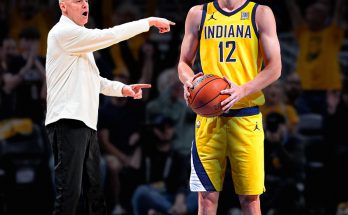Starting today, Ohio State will officially distribute \$18 million in revenue among athletes from its football, men’s and women’s basketball, and women’s volleyball programs.
Ohio State’s athletic department has officially ushered in a groundbreaking era in college sports by beginning to share $18 million in revenue with players from four of its high-profile programs: football, men’s basketball, women’s basketball, and women’s volleyball. This historic step marks a pivotal shift in how student-athletes are compensated, reflecting the growing acknowledgment of their critical role in generating the vast sums of money that fuel major college athletics. As of today, athletes participating in these programs will begin receiving a share of the institution’s earnings—a move that places Ohio State at the forefront of the evolving landscape of amateur sports and name, image, and likeness (NIL) rights.
This development has been in the making for several years, influenced by mounting legal pressure, public opinion, and the wider NIL movement that gained traction in 2021. Since that time, collegiate athletes have been allowed to profit from endorsements, social media, merchandise, and other business ventures. However, the sharing of direct institutional revenue with players had remained off-limits under NCAA regulations—until now. Ohio State’s new initiative, which provides direct revenue-sharing to athletes, breaks the traditional amateurism model that the NCAA has clung to for over a century. This shift doesn’t just redefine compensation; it redefines the entire relationship between universities and student-athletes.
The decision to include women’s sports—specifically women’s basketball and women’s volleyball—alongside the traditionally lucrative football and men’s basketball programs is also significant. It speaks to a broader understanding of value and fairness, emphasizing that equity and representation matter just as much as revenue generation. For decades, football and men’s basketball have been the primary engines of athletic department income, often at the expense of other sports that operate in the shadow of those financial giants. By extending revenue-sharing to athletes in women’s sports, Ohio State is not only embracing legal and economic change but also championing a more inclusive model for college athletics.
The mechanics of this $18 million revenue-sharing initiative are still being ironed out in fine detail, but what’s clear is that student-athletes in these four programs will now receive a tangible piece of the financial pie that they help bake. It’s not just about sharing profits—it’s about acknowledging the labor, time, commitment, and brand-building that student-athletes contribute daily. The typical week for a collegiate athlete is filled with early morning workouts, travel, games, classes, media duties, and community appearances. For years, these athletes were compensated primarily through scholarships, room, board, and academic resources. While these benefits were not insignificant, they often failed to reflect the true market value of the athletes’ contributions.
In football alone, the revenue generated by ticket sales, merchandise, sponsorships, and massive television deals can reach well into the hundreds of millions. Ohio State, with one of the most valuable football programs in the country, routinely draws massive crowds to Ohio Stadium and boasts a national brand that stretches far beyond the Midwest. The athletes who perform in front of these crowds, who wear the scarlet and gray under the bright lights, are a large part of the reason the Buckeyes’ brand is so strong. The same applies to the basketball programs, which also pull in considerable fan interest, especially during March Madness, and to women’s volleyball, which has consistently drawn large audiences and developed a loyal following.
With this new revenue-sharing model, Ohio State is making a statement—not just about where college athletics is headed, but about where it ought to go. While some universities have hesitated to take this leap, citing compliance questions or budgetary constraints, Ohio State has leaned into the moment. This willingness to be a leader, rather than a follower, reflects the university’s recognition that change is not only inevitable but necessary. It’s a forward-looking strategy that positions the Buckeyes as trailblazers in the modern era of college sports governance.
Of course, with any such sweeping change, questions abound. Will revenue-sharing eventually extend to other sports? How will these payments affect Title IX compliance? What are the long-term financial implications for athletic departments? Could revenue-sharing create a more professionalized college sports system, blurring the lines between the NCAA and professional leagues like the NFL or NBA? These are the kinds of questions that are now front and center, and the answers will likely evolve over time as more institutions follow suit and legal frameworks continue to develop.
Another major factor in this shift is the influence of ongoing legal battles challenging the NCAA’s authority and compensation limits. Cases like House v. NCAA have sought to dismantle the NCAA’s historic restrictions on how much athletes can be paid. These legal pressures, coupled with congressional debates about federal NIL legislation, have forced colleges and universities to rethink their models or risk being left behind—or worse, being held liable for backpay or damages in court. In many ways, Ohio State’s move to begin revenue-sharing is a preemptive one, designed to get ahead of the curve and establish a framework that is sustainable, equitable, and compliant with emerging norms.
The response from student-athletes has been largely positive. Many current players have expressed gratitude and excitement, not just for the financial benefit but for the acknowledgment that their work matters. For years, athletes have watched as coaches signed multi-million-dollar contracts, universities inked lucrative media deals, and athletic directors enjoyed performance bonuses—all while being told that their scholarship was compensation enough. This new system signals a more balanced approach to college sports economics.
There is also an educational component to this development. With more money flowing directly to athletes, universities must also enhance financial literacy education, ensuring that student-athletes understand taxes, budgeting, investment, and long-term planning. Just like professional athletes, college players will need guidance to manage newfound income responsibly. Ohio State is expected to continue building out its support systems to address this need, preparing athletes not just to perform on the field, but to thrive off of it as well.
Recruiting may also be influenced by this shift. Schools that offer revenue-sharing will naturally become more attractive destinations for top athletes. In an increasingly competitive landscape where NIL deals and personal branding are already central to recruiting conversations, revenue-sharing could become a decisive factor. Ohio State’s move may prompt a domino effect, where other programs—especially those in the Big Ten and SEC—feel compelled to match the offer or risk falling behind in talent acquisition.
Importantly, this change doesn’t signal the end of college sports as we know it, but rather the beginning of a more modern, fair, and transparent era. The foundational aspects that make college athletics special—teamwork, school pride, the journey from freshman to senior year, the blend of academic and athletic growth—can still thrive in a system where athletes are properly compensated. In fact, one could argue that fairness in pay enhances the integrity of college sports, allowing athletes to compete without the burden of financial instability or the pressure to seek under-the-table benefits.
Looking ahead, Ohio State’s $18 million revenue-sharing initiative could become a blueprint for other major programs across the country. The school has the resources, brand power, and administrative foresight to lead, and other universities may watch closely to see how this model unfolds. As college athletics continues to transform under the pressure of legal reform, economic realities, and cultural shifts, this moment will likely be remembered as a key turning point.
It’s a far cry from the amateurism ideals that defined the NCAA for generations, but it’s a change that reflects the modern understanding of fairness, labor, and rights. College athletes are no longer just students who play sports—they are public figures, brand ambassadors, and high-performance professionals in all but name. Ohio State’s decision to recognize that reality with direct compensation is more than a policy change—it’s a redefinition of the college sports experience for the 21st century.



